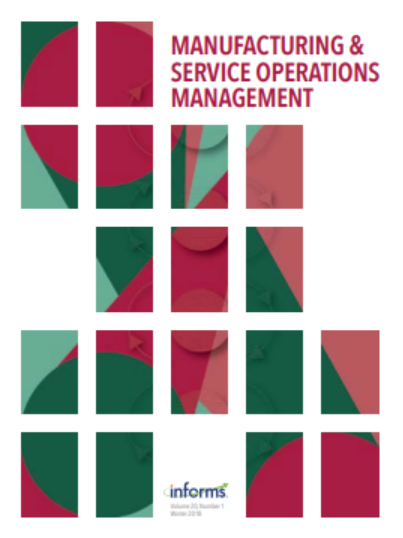Ancillary Services in Targeted Advertising: From Prediction to Prescription
IF 4.8
3区 管理学
Q1 MANAGEMENT
M&som-Manufacturing & Service Operations Management
Pub Date : 2023-07-01
DOI:10.1287/msom.2020.0491
引用次数: 0
Abstract
Problem definition: Online retailers provide recommendations of ancillary services when a customer is making a purchase. Our goal is to predict the net present value (NPV) of these services, estimate the probability of a customer subscribing to each of them depending on what services are offered to them, and ultimately prescribe the optimal personalized service recommendation that maximizes the expected long-term revenue. Methodology/results: We propose a novel method called cluster-while-classify (CWC), which jointly groups observations into clusters (segments) and learns a distinct classification model within each of these segments to predict the sign-up propensity of services based on customer, product, and session-level features. This method is competitive with the industry state of the art and can be represented in a simple decision tree. This makes CWC interpretable and easily actionable. We then use double machine learning (DML) and causal forests to estimate the NPV for each service and, finally, propose an iterative optimization strategy—that is, scalable and efficient—to solve the personalized ancillary service recommendation problem. CWC achieves a competitive 74% out-of-sample accuracy over four possible outcomes and seven different combinations of services for the propensity predictions. This, alongside the rest of the personalized holistic optimization framework, can potentially result in an estimated 2.5%–3.5% uplift in the revenue based on our numerical study. Managerial implications: The proposed solution allows online retailers in general and Wayfair in particular to curate their service offerings and optimize and personalize their service recommendations for the stakeholders. This results in a simplified, streamlined process and a significant long-term revenue uplift. History: This paper has been accepted as part of the 2021 Manufacturing & Service Operations Management Practice-Based Research Competition. Supplemental Material: The online appendix is available at https://doi.org/10.1287/msom.2020.0491 .定向广告中的辅助服务:从预测到处方
问题定义:在线零售商在顾客购物时提供辅助服务的建议。我们的目标是预测这些服务的净现值(NPV),根据提供给他们的服务估计客户订阅每种服务的概率,并最终规定最佳的个性化服务推荐,使预期的长期收入最大化。方法/结果:我们提出了一种称为聚类同时分类(CWC)的新方法,该方法将观察结果联合分组到聚类(细分)中,并在每个细分中学习不同的分类模型,以基于客户,产品和会话级别的特征来预测服务的注册倾向。该方法与行业的最新技术相竞争,可以用简单的决策树表示。这使得《禁止化学武器公约》具有可解释性和可操作性。然后,我们使用双机器学习(DML)和因果森林来估计每个服务的NPV,最后,提出一个迭代优化策略-即可扩展和高效-来解决个性化辅助服务推荐问题。对于倾向预测,CWC在四种可能的结果和七种不同的服务组合上实现了74%的样本外精度。根据我们的数值研究,与其他个性化整体优化框架一起,这可能会导致收入增加2.5%-3.5%。管理意义:建议的解决方案允许在线零售商,特别是Wayfair,策划他们的服务产品,并为利益相关者优化和个性化他们的服务建议。这导致了一个简化的、流线型的流程和显著的长期收入提升。历史:本文已被接受为2021年制造业&服务营运管理实务研究比赛。补充材料:在线附录可在https://doi.org/10.1287/msom.2020.0491上获得。
本文章由计算机程序翻译,如有差异,请以英文原文为准。
求助全文
约1分钟内获得全文
求助全文
来源期刊

M&som-Manufacturing & Service Operations Management
管理科学-运筹学与管理科学
CiteScore
9.30
自引率
12.70%
发文量
184
审稿时长
12 months
期刊介绍:
M&SOM is the INFORMS journal for operations management. The purpose of the journal is to publish high-impact manuscripts that report relevant research on important problems in operations management (OM). The field of OM is the study of the innovative or traditional processes for the design, procurement, production, delivery, and recovery of goods and services. OM research entails the control, planning, design, and improvement of these processes. This research can be prescriptive, descriptive, or predictive; however, the intent of the research is ultimately to develop some form of enduring knowledge that can lead to more efficient or effective processes for the creation and delivery of goods and services.
M&SOM encourages a variety of methodological approaches to OM research; papers may be theoretical or empirical, analytical or computational, and may be based on a range of established research disciplines. M&SOM encourages contributions in OM across the full spectrum of decision making: strategic, tactical, and operational. Furthermore, the journal supports research that examines pertinent issues at the interfaces between OM and other functional areas.
 求助内容:
求助内容: 应助结果提醒方式:
应助结果提醒方式:


